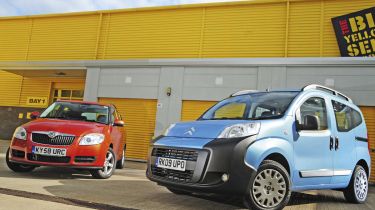Skoda Fabia 2 Estate
Is van-like newcomer a more practical choice than a traditional load carrier?
If there’s one area where the van-based Nemo is sure to score good results, it’s in the space race. Thanks to its boxy body, the French car should be at the top of the list for buyers looking for a small load carrier.
However, the practical Citroen isn’t the only alternative. A number of manufacturers now build spacious supermini estates – and the Skoda Fabia is one of the biggest. The Czech wagon’s impressive capacity shames some models from the class above, while its £11,555 list price means you pay a premium of only £560 over the less well equipped Nemo.
Visually, the sober-looking Skoda is a very different proposition to the square Citroen. In profile the Fabia takes its cues from traditional estate cars, with an extended roofline and upright tail. From the base of the screen forward, it is identical to the hatchback version, complete with prominent chrome grille and large lights.
For estate buyers, the business end of a vehicle is always the rear – and the Skoda doesn’t disappoint.
The large tailgate cuts into the roof to provide a taller opening, and reveals a useful 480-litre boot – a healthy 120 litres more than in the Nemo. Serious effort has clearly gone into the load area, as there are two deep storage bins set into the sides, while a plastic retaining strap holds shopping bags in place.
Better still, if you fold the Fabia’s 60/40-split rear bench, the amount of space available increases to 1,460 litres. That’s impressive – yet the Nemo boasts a neat trick for those who want to carry even more. Not only does it have a lower load height than the Skoda, the back seats can be removed altogether.
This is a job for two people, as the Citroen’s bulky chairs are quite heavy. But once they are out of the way, you are left with an enormous 2,500-litre capacity – a figure unrivalled even by full-size estates.
Tricky
Neat touches in the Nemo’s boot include anchor points in the floor, plus rubber bungies for strapping down smaller items. The Citroen is not without fault, though, because its huge tailgate is tricky to open in tight spaces such as crowded car parks. Still, it doubles as a handy shelter on family picnics and keeps rain off your back when filling the boot in wet weather.
Our two contenders are more closely matched when it comes to occupant accommodation. Passengers in the back get similar amounts of space in both cars, although the Fabia’s smaller rear side windows mean the cabin doesn’t feel as airy as that of the Nemo.
On the other hand, the Skoda is much more robust, with its smartly styled dashboard constructed from decent-quality materials. There’s also more standard kit, including air-conditioning and an auxiliary input for portable music devices.
The Fabia extends its advantage at the test track, thanks to its 85bhp 1.4-litre petrol engine. It sprinted from 0-60mph in 12.4 seconds, which is a significant 5.7 seconds faster than its French rival.
On the road, though, these two competitors are more evenly matched. The Skoda lacks low-speed urge, meaning the powerplant needs to be worked hard to make the most of its performance advantage.
As with the Nemo, the Fabia features a soft suspension set-up. Consequently, the ride is very comfortable, and the car soaks up everything from potholed urban streets to motorway undulations. Thanks to its weightier steering and low-slung driving position, the Fabia feels more agile in corners, too.
For some buyers, the Nemo will be a more desirable proposition because of its ability to transform into a van and its superior fuel economy. But the Skoda’s boot will be sufficient for most people, and its higher-quality cabin and longer kit list make it a great-value choice.
So the Citroen is pushed into second place again.







